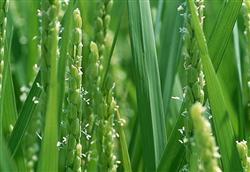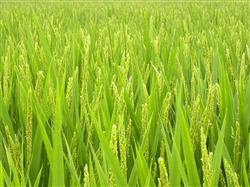What should be paid attention to in the later stage of planting rice?

What should be paid attention to in the later stage of planting rice? Please give an introduction to the following aspects that should be paid attention to in the later stage of planting rice: 1. Water management in the later stage: do a good job in field water management, ensure smooth heading and flowering, maintain root activity, and ensure smooth filling. Keep deep water in the field at booting and heading stage, but it is not suitable to irrigate deep water for too long. During the filling period, the opportunity of soil aeration should be increased under the condition of water supply in the field, so as to maintain roots and protect leaves, prolong root activity and prevent premature senescence of leaves. The specific water management measures are as follows: let the water layer dry naturally after heading, then irrigate every 5-6 days, and then let it dry naturally to make the field dry and wet, so as to keep the soil aerated and moist, maintain the vitality of the old root, promote the new root, maintain the vitality of the functional leaves, and increase the grain weight. Do not cut off water too early in the mature period, usually about a week before harvest. 2. control of diseases and insect pests: focus on the control of rice planthopper, rice leaf roller, Chilo suppressalis, Chilo suppressalis, rice stem borer, sheath blight, rice blast, rice false smut, stripe blight and so on. Comprehensive use of agricultural and ecological control techniques, trapping and killing techniques, biological control techniques and the application of selective, efficient and environment-friendly pesticides to achieve standard control, and master the appropriate period for control, pesticide application and application methods. Each pesticide variety is used no more than twice a season to prevent pests from producing drug resistance. Promote the control of rice planthopper with buprofezin, pyrethrin and imidacloprid, imidacloprid against white-backed planthopper, probophos and chlorobenzamide against rice leaf roller, prochloraz and tricyclazole to control rice blast, insecticides such as Shachongshuang and Shachongdan to control rice borer. The application of Bacillus thuringiensis (Bt) preparation to control Chilo suppressalis and Chilo suppressalis medinalis can effectively control pests and protect natural enemies in rice field. Bacillus subtilis and Chunreomycin were used to prevent rice blast, well wax bud preparation to prevent rice false smut and sheath blight, and Jinggangmycin to prevent sheath blight in the areas with frequent occurrence of rice blast and false smut and susceptible varieties. Ningnanmycin was used in combination with insecticides to prevent and reduce the harm of virus diseases such as stripe blight and black streak dwarf disease in rice virus disease endemic areas. (1) Rice blast: neck blast must be sprayed twice in advance. One was at the breaking stage at the end of booting, and the other was at full heading and flowering stage, with an interval of about 10 days. Use 20% tricyclazole wettable powder 100 grams per mu or Fuji No. 1 EC 60,70ml, add water 50kg and 60kg conventional spray. Note: drugs must be used at the end of booting and full heading stage, but not at flowering stage. The pesticide should be sprayed before 8am and after 4pm. Long-acting agents were selected at the end of booting stage. After taking medicine once at full heading stage, if Rain Water is too much, take the medicine again 5 days later. (2) sheath blight: it was carried out twice from jointing to heading stage, with an interval of 7-10 days. The method is as follows: 20% Jinggangmycin powder 25 grams per mu, adding water 10-50 kg spray, must be sprayed to the stem disease spot. (3) bacterial blight: in serial irrigated fields and areas prone to bacterial blight, 50 kg of water and 75-100 g of 20% Yekuning were used to control bacterial blight. Pay attention to control the disease center. (4) Rice false smut: to control rice false smut with 5% Jingangmycin 300ml / mu (also for the treatment of stripe withering) or 40% Hekuling 75g or 15.5% Baosuining 80g 100g water spray per mu. It was controlled for the first time in 7 days before the break stage of rice, and again at the full heading stage. (5) Borer: during the heading stage of rice, the pesticide was applied from the peak egg hatching stage to the young larva stage. Spray 60 kg of water evenly with 5% Regent per mu. The effect of keeping the shallow water layer for 3-5 days is better. Generally speaking, the drug should be applied about one week after the peak of egg hatching. (6) Rice leaf roller: control from the peak of egg hatching to the stage of young larvae. Spray 60 kg of water evenly with 48% Lesbon EC 80 ml or 5% fipronil 60 ml per mu. (7) Rice planthopper: 60 grams of 10% imidacloprid wettable powder or 40 grams of rice planthopper (25% buprofezin wettable powder) were sprayed evenly on 60 kg of water per mu. The critical period of control is the occurrence period of the young nymph of the main damage generation. Spray first at the edge of the field and then in the middle. 3. Applying proper foliar fertilizer to increase 1000-grain weight: after heading, the root activity of hybrid rice decreased, the functional leaves gradually withered, and it was easy to lose fertilizer, which led to premature yellowing and death of leaves and weakening of photosynthesis of rice plants. Supplementary application of grain fertilizer can prevent premature senescence of functional leaves, increase seed setting rate and increase 1000-grain weight. Foliar spraying is the main method of application. Urea per mu with 0.5 kg to water 50-100 kg, spraying concentration of 1%. Potassium dihydrogen phosphate is sprayed with 150 grams of water and 75 kilograms per mu. The concentration of trace elements sprayed is generally 0.01-0.1%. Pay attention to the spray to carefully read the instructions, can not be excessive, the amount of water should be sufficient, so as not to burn the seedlings with too much solution concentration. Click to get more rice planting techniques click to get more food crop planting techniques
- Prev

How to manage rice in the later stage?
How to manage rice in the later stage? Please introduce the management methods of rice in the later stage, we can refer to the following methods: first, the late growth stage of rice for disaster prevention and resistance is the frequent season of typhoon, rainstorm, abnormal low temperature and extremely high temperature, so we should firmly establish the consciousness of resisting disasters and winning a bumper harvest. always pay attention to weather information, not to rice fields.
- Next

How to control diseases and insect pests in the later stage of rice?
How to control diseases and insect pests in the later stage of rice? Please give guidance on the serious harm of diseases and insect pests in the later stage of rice. Control methods can be referred to as follows: 1. Sheath blight: the recent increase in sheath blight has accelerated. According to the general survey in various towns on September 10, the average rate of diseased holes is 13.7%, and the rate of diseased plants is 3.3%. The increase in the disease was significantly faster than that in the previous period.
Related
- The first cup of black tea in spring, the flavor and history of tea gardens in Kenya, Africa
- The computer can not only choose potatoes, but also grow tea rice. AI will grow winter oolong tea champion.
- It is not only the inflated tea bitten by insects, but also engraved with the four seasons tea in Beipu.
- The Oriental Beauty Tea Festival in Zhuxian County takes the stage at the weekend to experience the plus-size feast of oil tea.
- & quot; Oriental Beauty Tea & Exploration of Emei in Hsinchu, the hometown of quot;
- The new variety of strawberry "Tainong 1" dessert is the first choice with mellow aroma. Crimson gorgeous
- History of Tea in Taiwan: from Wild Inner Mountain to Export Tea Garden
- Two types of Taiwan Oriental Beauty Black Tea won the British three-Star Award for Childhood Tea Xiang Zhang Jiaqi changed from pilot to champion tea maker.
- Banana species and varieties: the planting history of Taiwan Xianren banana and dwarf banana is long, is banana disease resistant?
- Coffee planting Technology: Qianjie Coffee from Seedling to harvesting

